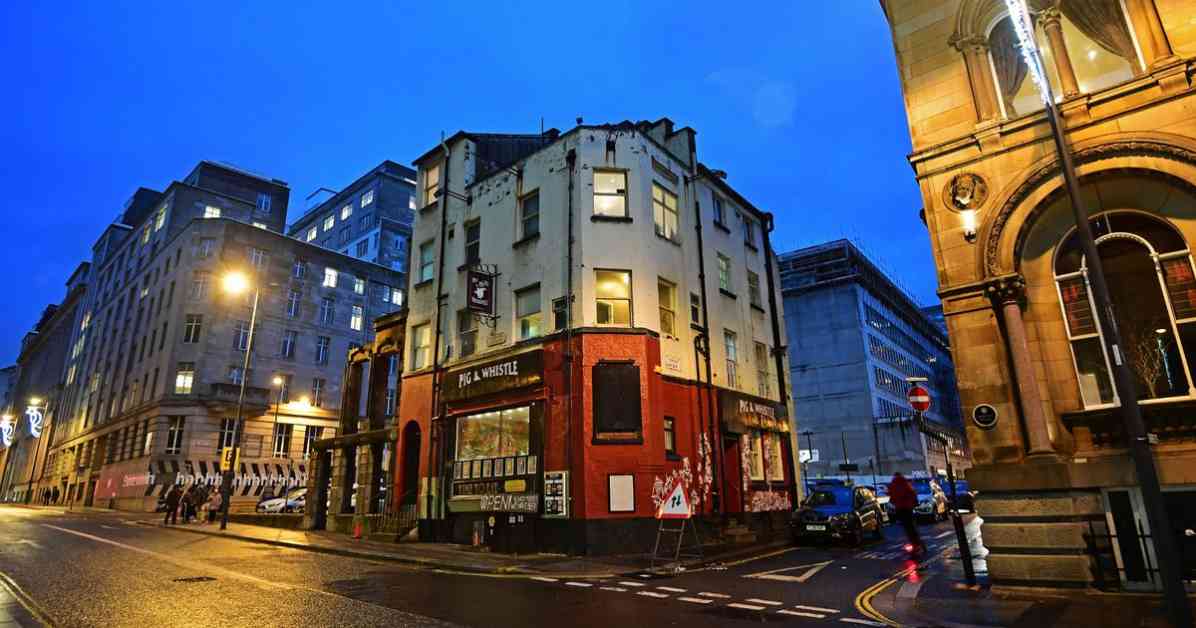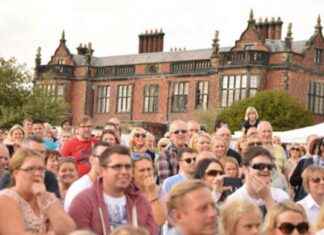The Pig & Whistle, a historic pub in Liverpool city centre, has long been surrounded by myths and misconceptions regarding its history. Many believed that the surrounding buildings were destroyed during the Blitz in World War II, leaving the pub as the last remaining structure on its block. However, recent revelations have debunked this popular narrative, shedding light on the true fate of the buildings that once stood alongside The Pig & Whistle.
The Blitz, a series of devastating bombing raids carried out by the German Luftwaffe between 1940 and 1942, caused widespread destruction in Merseyside. Liverpool, along with Bootle and Birkenhead, was targeted due to its strategic importance as a large west coast port with connections to North America. The region suffered heavy casualties, with thousands of lives lost and significant damage to buildings and infrastructure.
Among the architectural casualties of the Blitz was St Luke’s Church, a prominent landmark in Liverpool city centre. The church, also known as the bombed-out church, was gutted by bombing in May 1941 but remained standing as a symbol of resilience and remembrance. Other notable buildings, such as the Custom House, the Bluecoat Chambers, and the Liverpool Museum, also sustained damage during the wartime bombings.
In the aftermath of the war, some buildings were restored while others were demolished. Many bomb sites remained untouched for years, serving as reminders of the destruction wrought by the conflict. It was commonly believed that the area surrounding The Pig & Whistle pub on Chapel Street had been decimated during the Blitz, leaving the pub as the sole survivor on its block.
However, new information has come to light, challenging this long-held belief. According to a reader named Mark Anthony Craig, the buildings that once stood next to The Pig & Whistle were not actually destroyed during the war. St Peter’s Buildings, the structures that surrounded the pub, remained intact throughout the bombing raids. It was not until the early 1970s that the buildings were demolished by the council as part of a redevelopment plan for the commercial district.
The revelation that St Peter’s Buildings survived the Blitz has corrected a common misconception about the history of The Pig & Whistle and its surroundings. The buildings were not lost to wartime destruction but were instead removed as part of a post-war redevelopment initiative. This new information has reshaped our understanding of the pub’s place in Liverpool’s architectural landscape.
The Myth of the Lone Pub
For years, the story of The Pig & Whistle as the last remaining building on its block has captured the imagination of Liverpool residents. The image of a lone pub standing defiantly amid the rubble of war was a powerful symbol of resilience and survival. However, the truth behind this myth reveals a more complex and nuanced history of urban development in the city.
The misconception that the surrounding buildings were destroyed in the Blitz speaks to a larger narrative of wartime destruction and reconstruction. The scars of the war were visible in the form of bombed-out buildings and vacant lots that remained untouched for years. The idea that The Pig & Whistle was the only structure left standing on its block added to the mystique of the pub and its place in Liverpool’s collective memory.
Revealing the Real Story
The revelation that St Peter’s Buildings were not lost in the Blitz but were instead demolished in the 1970s sheds new light on the history of The Pig & Whistle and its surroundings. The decision to remove the buildings as part of a redevelopment plan reflects the changing priorities of post-war urban planning. The council’s efforts to modernize the commercial district and attract new investment reshaped the physical landscape of the city.
The preservation of The Pig & Whistle in the face of redevelopment offers a unique glimpse into the challenges of balancing heritage preservation with economic progress. The reluctance of developers to demolish the pub and the awkward layout of the site due to the missing buildings highlight the complexities of urban planning and historic preservation. The pub’s survival as a relic of the past in a rapidly changing city speaks to the enduring appeal of historic landmarks in the midst of modernization.
Lessons Learned
The debunking of the myth surrounding The Pig & Whistle serves as a reminder of the importance of historical accuracy and context in shaping our understanding of the past. The story of the lone pub was a compelling narrative that captured the imagination of many, but it was ultimately based on misinformation and misconception. By uncovering the true history of the surrounding buildings and their fate, we gain a deeper appreciation for the complexities of urban development and preservation.
The case of The Pig & Whistle also highlights the challenges of balancing heritage conservation with urban renewal. The preservation of historic landmarks in the face of redevelopment requires careful consideration of the value of the past in shaping the future. The pub’s continued existence as a reminder of a bygone era in the midst of a rapidly changing city underscores the importance of preserving our architectural heritage for future generations.
In conclusion, the unveiling of the truth behind the misunderstood history of The Pig & Whistle offers a valuable lesson in the importance of historical accuracy and context. By challenging popular myths and misconceptions, we gain a deeper understanding of the complexities of urban development and preservation. The pub’s survival as a relic of the past in a modernizing city serves as a reminder of the enduring value of historic landmarks in shaping our collective memory.




















